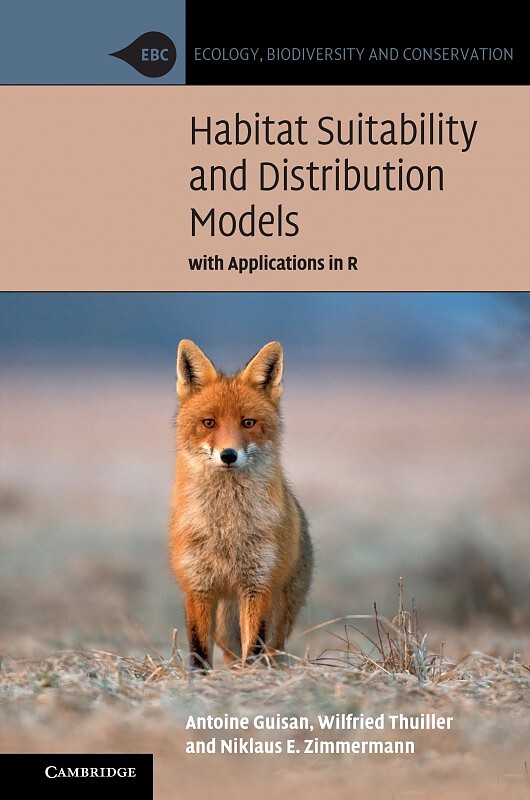Introduction
1 General content of the book
1.1 What is this book about?
1.2 How is the book structured?
1.3 Why write a textbook with R examples?
1.4 What is this book not about?
1.5 Why was this book needed?
1.6 Who is this book for?
1.7 Where can I find supporting material?
1.8 What are readers assumed to know already?
1.9 How does this book differ from previous ones?
1.10 What terminology is used in this book?
PART I - Overview, Principles, Theory and Assumptions Behind Habitat Suitability Modeling
2 Overview of the Habitat Suitability Modeling Procedure
2.1 The different methodological steps of HSM
2.2 The initial conceptual step
3 What Drives Species Distributions?
3.1 The overall context: dispersal, habitat, and biotic filtering
3.2 Speciation, dispersal, species pools, and neutral theory
3.3 The abiotic environment: habitats and fundamental niches
3.4 The biotic environment: species interactions, community assembly, and realized niches
3.5 Further discussion of the realized environmental niche and other related niche concepts
4 From Niche to Distribution: Basic Modeling Principles and Applications
4.1 From geographical distribution to niche quantification
4.2 From the quantified niche to spatial predictions
4.3 From individual species predictions to communities
4.4 Main fields of application
5 Assumptions behind Habitat Suitability Models
5.1 Theoretical assumptions behind HSMs
5.2 Methodological assumptions
PART II - Data Acquisition, Sampling Design, and Spatial Scales
6 Environmental Predictors: Issues of Processing and Selection
6.1 Existing environmental databases
6.2 Performing simple GIS analyses in R
6.3 RS-based predictors
6.4 Properties and selection of variables
7 Species Data: Issues of Acquisition and Design
7.1 Existing data and databases
7.2 Spatial autocorrelation and pseudo-replicates
7.3 Sample size, prevalence, and sample accuracy
7.4 Sampling design and data collection
7.5 Presence–absence vs. presence-only data
8 Ecological Scales: Issues of Resolution and Extent
8.1 Issues of resolution
8.2 Issues of extent
PART III - Modeling Approaches and Model Calibration
9 Envelopes and Distance-based Approaches
9.1 Concepts
9.2 Envelope approaches
9.3 Distance-based methods
10 Regression-based Approaches
10.1 Concepts
10.2 Generalized linear models
10.3 Generalized additive models
10.4 Multivariate adaptive regression splines
11 Classification Approaches and Machine-learning Systems
11.1 Concepts
11.2 Recursive partitioning
11.3 Linear discriminant analysis and extensions
11.4 Artificial neural networks
12 Boosting and Bagging Approaches
12.1 Concepts
12.2 Random forests
12.3 Boosted regression trees
13 Maximum Entropy
13.1 Concepts
13.2 Maxent in R
14 Ensemble Modeling and Modeling Averaging
PART IV - Evaluating Models: Errors and Uncertainty
15 Measuring Model Accuracy: Which Metrics to Use?
15.1 Comparing predicted probabilities of presence to presence–absence observations
15.2 Comparing probabilistic predictions to presence-only observations
16 Assessing Model Performance: Which Data to Use?
16.1 Assessment of model fit using resubstitution and randomization
16.2 Internal evaluation by resampling
16.3 External evaluation (fully independent data)
PART V - Predictions in Space and Time
17 Projecting Models in Space and Time
17.1 Additional considerations and assumptions when projecting models: analog environment, niche completeness, and niche stability
17.2 Projecting species distributions in space
17.3 Projecting species in time
17.4 Ensemble projections
PART VI - Data and Tools Used in this Book, with Developed Case Studies
18 Datasets and Tools Used for the Examples in this Book
19 The Biomod2 Modeling Package Examples
19.1 Example 1: HSM of Protea laurifolia in South Africa
19.2 Example 2: creating diversity maps for the Laurus species
PART VII - Conclusions and Future Perspectives
20 Conclusions and Future Perspectives in Habitat Suitability Modeling
20.1 Further progress in HSMs through metagenomics and remote sensing
20.2 Point-process models for presence-only data
20.3 Hierarchical Bayesian approaches to integrate models at different scales
20.4 Ensemble of small models for rarer species
20.5 Improving the modeling techniques to fit simple and ensemble HSMs
20.6 Multi-species modeling and joint-species distribution modeling
20.7 Use of artificial data
Glossary and Definitions of Terms and Concepts
Methods, approaches, models, techniques, algorithms
ENM, SDM, HSM, etc.: different names and acronyms for the same models!
Environment, habitat, niche, niche-biotope duality, and distribution
Technical acronyms for the most commonly used modeling techniques

